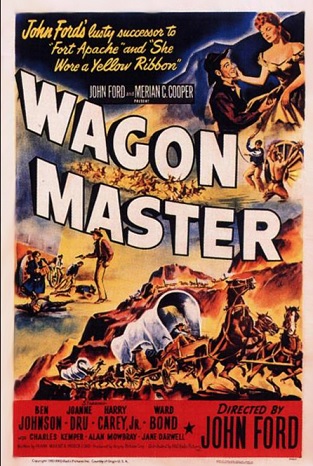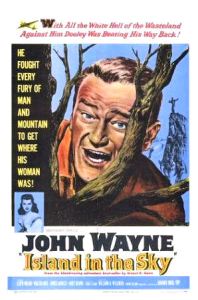 The late 1940s and early 1950s were undoubtedly John Ford‘s strongest era as a director. His strongest contributions, not so surprisingly, of the time (with the exception of The Quiet Man) came from the genre he’s most associated with, the western. And while his famed cavalry trilogy — Fort Apache, She Wore a Yellow Ribbon, Rio Grande — is synonymous with the genre, another western of the time gets lost in the shuffle and is almost entirely forgotten. Here’s 1950’s Wagon Master.
The late 1940s and early 1950s were undoubtedly John Ford‘s strongest era as a director. His strongest contributions, not so surprisingly, of the time (with the exception of The Quiet Man) came from the genre he’s most associated with, the western. And while his famed cavalry trilogy — Fort Apache, She Wore a Yellow Ribbon, Rio Grande — is synonymous with the genre, another western of the time gets lost in the shuffle and is almost entirely forgotten. Here’s 1950’s Wagon Master.
It’s the 1880s in the American west and a group of Mormon settlers is being chased further west, populations in towns along the trail wanting nothing to do with the settlers. Looking to build a community in California, a Mormon wagon train — led by fiery Elder Wiggs (Ward Bond) asks two horse traders, Travis (Ben Johnson) and Sandy (Harry Carey Jr.) to work as wagon masters, driving the train west. It takes some convincing, but the two amiable horse traders take the job on. They’re working against the seasonal clock though, the Mormons needing to reach their California valley and plant a harvest before winter settles in. Throw in some gunfighters, bandits and Indian attacks, and the trail is anything but easy.
Remembered with The Searchers and The Quiet Man as Ford’s best, the cavalry trilogy are Ford working at his absolute best. Even 3 Godfathers — released in 1948 — is a gem. Why then is ‘Wagon’ so generally forgotten? Well, the obvious answer is that there’s no big star, no John Wayne or Henry Fonda. Instead, Ford gives the spotlight to three instantly recognizable character actors who often played supporting parts in his movies; Ben Johnson, Harry Carey Jr. and Ward Bond. More on our stars later, but the key here is Ford turning into a simpler, more lyrical story. It plays a little like a serial, slightly disjointed at 86 minutes. The wagon train moving west is about as iconic as a western gets, and Ford doesn’t miss here.
How accurate are Ford’s westerns to the actual wild west American history? His films always looked authentic, always felt authentic. The moral of the story though is simple to describe. Maybe they’re not the most authentic or realistic. Instead, Ford presents the American west as it should have been. It’s good guys vs. bad guys, noble heroes vs. dastardly villains, beautiful vistas and damsels in distress. ‘Wagon’ has all of that, a stripped-down story of a wagon train. Filmed on location in Monument Valley, ‘Wagon’ is a black-and-white gem. The backdrops are simply stunning. With a film a little light on story, the locations (set to composer Richard Hageman’s score, a frequent Ford composer) end up stealing the show.
Coupled with the Monument Valley locations, the trio of character actors getting lead roles is what’s brought me back to ‘Wagon.’ A real-life cowboy before Ford discovered him, Johnson is at his laconic, scene-stealing best. When Johnson’s Travis is tearing across the Utah desert, that’s him doing the riding, not a stunt double. As his buddy Sandy, Carey Jr. is a naive but nice (somewhat dim-witted) cowboy. The duo actually starred the same year in Ford’s Rio Grande, playing characters with the same names. Is ‘Wagon’ an unofficial sequel of sorts? Throw in the always welcome Ward Bond as Elder, a converted Mormon with a hinted-at checkered past, and you’ve got a heck of a lead trio. No huge stars, no problem.
Starring as love interests are Joanne Dru and Kathleen O’Malley. Ford regulars Jane Darwell, Russell Simpson and Francis Ford (John’s older brother) playing supporting parts. The villains are the Cleggs gang, led by murdering patriarch Shiloh (Charles Kemper) and including supporting parts for Hank Worden, James Arness, Fred Libby and Mickey Simpson. Also look for Alan Mowbray as a snake oil salesman and Ruth Clifford as his dance hall girl partner.
As I’ve mentioned, ‘Wagon’ isn’t the most pointed story around. It drifts a little bit, and the ending is especially odd, as if Ford didn’t quite know how or when to end his movie. There is not a ton of action along the way, but you’re watching for the characters and the location backdrop. When the Cleggs are re-introduced in the second act, the introduction does provide some uncomfortable tension going forward. Still, even with its flaws, it’s still a pretty good western. A few too many songs too along the way, along with 2 different community line dances (usual Ford touches).
Not on the level of the cavalry trilogy or Ford’s other classics, but a must-watch for western and John Ford fans alike.
Wagon Master (1950): ***/****

 Since I moved over to WordPress from Blogger this past fall, I’ve struggled with what to review. Life gets in the way and what not, huh? Should I stick with solely westerns? Guy’s guys movies in general? I’d been sticking with westerns of late, but when watching 1953’s
Since I moved over to WordPress from Blogger this past fall, I’ve struggled with what to review. Life gets in the way and what not, huh? Should I stick with solely westerns? Guy’s guys movies in general? I’d been sticking with westerns of late, but when watching 1953’s  So what’s more unnecessary than a remake of a classic? A TV movie remake of a classic! Released in 1948 and starring John Wayne and Montgomery Clift from director Howard Hawkes, the original Red River is a classic western that’s undone by one of the worst endings in the western genre. So some 40 years later, the TV remake hit TV screens on CBS. Here’s 1988’s
So what’s more unnecessary than a remake of a classic? A TV movie remake of a classic! Released in 1948 and starring John Wayne and Montgomery Clift from director Howard Hawkes, the original Red River is a classic western that’s undone by one of the worst endings in the western genre. So some 40 years later, the TV remake hit TV screens on CBS. Here’s 1988’s